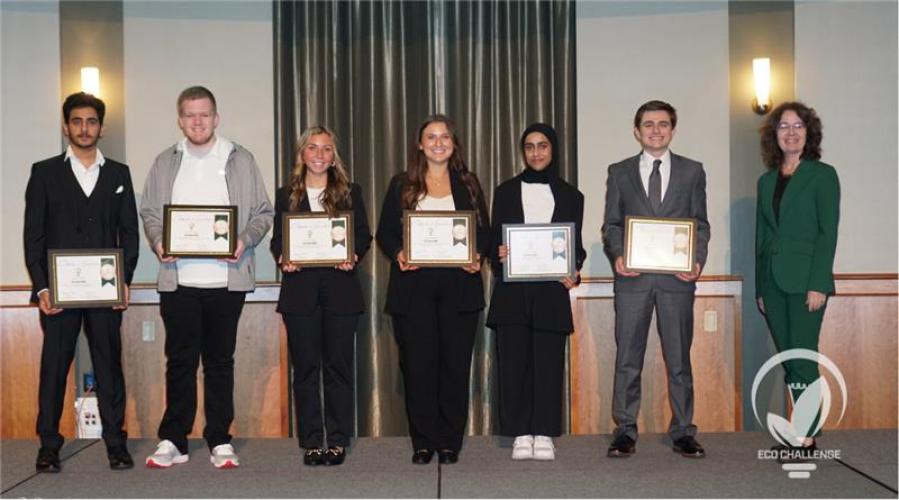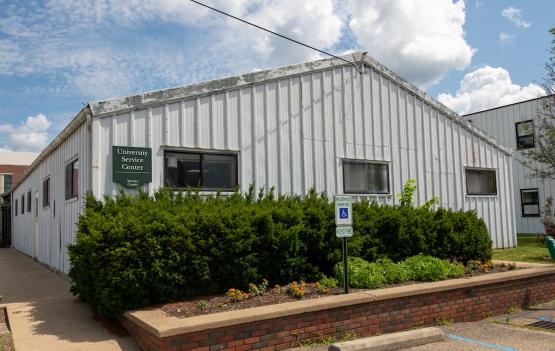
照亮通往更绿色未来的道路:俄亥俄大学的生态挑战

俄亥俄大学不仅仅是学生们学习可持续发展的地方,俄亥俄的学生们正在积极地在校园内塑造可持续发展。
One example of this is the Eco Challenge, a groundbreaking initiative that empowers students to spearhead projects that make a tangible environmental impact.
Supported by Ohio University alumnus Dan Squiller, the Eco Challenge is not your average classroom exercise. The initiative, in fact, is part of three Ohio University classes – MGT 3435 Leadership in Practice, ENE 4100 Energy Engineering Senior Design, and ME 2900 Eco- Challenge – for students in the College of Business and the Russ College of Engineering and Technology.
Started by Squiller and former director of the Robe Leadership Institute Dave Bayless, the initiative is also supported each year by the Ohio University Office of Sustainability.
This innovative challenge allows students to engage in real-world, hands-on projects that align directly with the University's sustainability goals.
Led by Kim Jordan, who also directs the Strategic Leadership Certificate program in the College of Business, and Dr. Greg Kremer, who leads the Robe Leadership Institute in the Russ College of Engineering and Technology, the Eco Challenge fosters collaboration among disciplines and colleges, providing students with a unique platform to drive change through experiential learning.
An innovative multidisciplinary approach has created fertile ground for collaboration between the College of Business, Russ College of Engineering and Technology, and the Scripps College of Communication, expanding the scope and depth of the projects over the years.
OHIO students excel in the competition
The latest success story comes from the ninth annual Eco Challenge on Nov. 24, 2024. Team Six — made up of Avery Murdock, Kiley Scanlon, Nathan Jennings, Espen Elliot, Manar Al Ghailani, and Mazin Al Jahwari—earned top honors with a clever plan to overhaul the lighting in the University Service Center at 49 Factory Street in Athens.
Their project—swapping outdated bulbs with energy-efficient LED lighting—was a step toward reducing the University’s carbon footprint and saving the University money in electricity costs.
OHIO’s University Service Center, built in 1966, is home to the offices of Maintenance, Operations, and Grounds Services employees. In its Eco Challenge project, Team Six aimed to lower energy consumption by upgrading the lighting and creating a more sustainable, cost-effective workspace at the University Service Center. The team’s proposal was simple and transformative: replace 610 existing bulbs—each consuming 17 watts of power—with 514 LED bulbs that use only 9 watts.

The result? A projected 50% reduction in energy use that translates to an estimated annual savings of $1,419 in electricity costs.
However, the project required more than just swapping out bulbs. It called for retrofitting the existing lighting infrastructure, which added additional time and complexity to the installation process. While the team initially expected a straightforward conversion, they quickly realized that retrofitting would be necessary to accommodate the new LED fixtures. This step would involve modifying the electrical systems and fittings, extending the timeline, and requiring additional planning to ensure seamless installation.
Vince Weatherstein, director of energy management at Ohio University, played a key role in helping bring the student project to life.
“It’s great that we have a program that allows students to develop solutions based on real life challenges,” Weatherstein said. “The Eco Challenge prepares students for experiences they will face after graduation. It was an honor to be able to work with a team that wanted to focus on energy efficiency.”
The OHIO students on Team Six identified an area using energy-intensive fluorescent bulbs and recommended an LED solution reducing energy consumption by 50%.
“This project saves the University operating dollars and aligns with the University’s goal of carbon neutrality by 2050. When the students presented this project, it was a no-brainer to implement due to its cost versus the yearly operating cost savings,” Weatherstein said. “We successfully implemented this project before the end of the school year so the students could see their ideas and hard work come to fruition. I’m very excited about the next Eco Challenge class and cannot wait to see the ideas the students generate.”
The return on investment was compelling: the upfront installation cost of $5,944 would be recouped quickly, thanks to the energy savings. However, the project was not without its challenges.
Working together to overcome challenges
Team Six identified several potential risks, including electrical malfunctions, financial uncertainties, and operational disruptions during installation. Through meticulous planning and careful consideration of these challenges, the team organized the project in a way that allowed for a smooth and timely installation, ensuring the project’s completion in alignment with Ohio University’s sustainability goals.
The Eco Challenge, which brings together experts like Weatherstein and Ohio University Facilities, is a model for how academic institutions can integrate sustainability into their educational framework. Students don’t just study climate solutions; they create them. This hands-on approach equips participants with the practical skills and experience to address some of the world’s most pressing environmental challenges.
Looking ahead, Ohio University is set to celebrate a milestone: the 10th anniversary of the Eco Challenge in November 2025. This decade of innovation will showcase the program's lasting impact and the transformative role students play in shaping a sustainable future. Squiller’s continued support ensures that the Eco Challenge remains a cornerstone of Ohio University's sustainability efforts, inspiring generations of students to drive positive change for the planet.
The benefits of this project are already being felt. Employees working in the University Service Center enjoy the bright, efficient lighting, which has improved the workspace environment and contributed to energy savings in real time. The new LED fixtures provide better illumination, enhancing visibility and comfort while reducing the building's overall energy consumption—furthering the University's commitment to sustainability.
